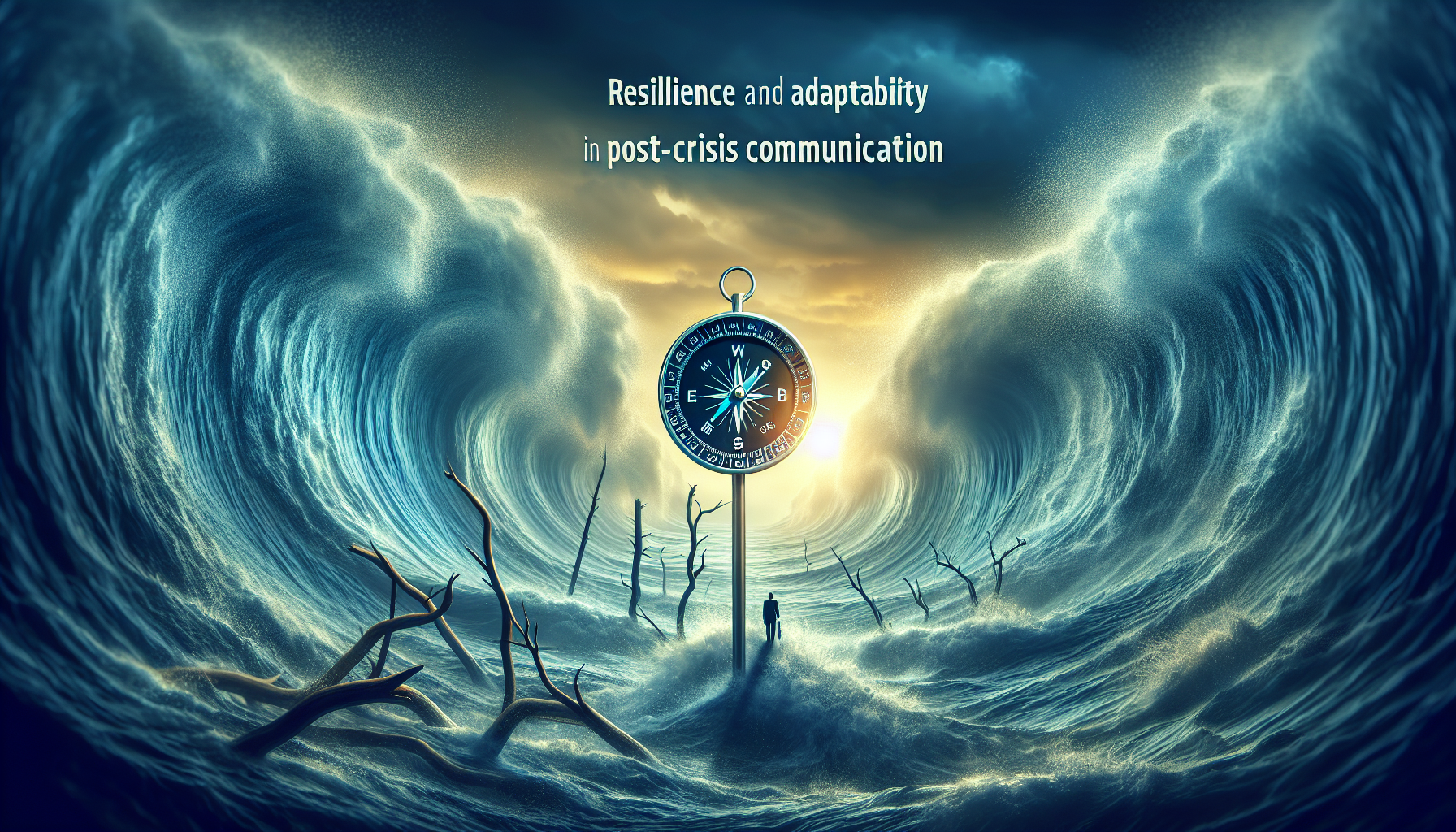Table of Contents Show
In the aftermath of a crisis, effective communication becomes paramount for individuals and organizations alike. It is during these challenging times that the ability to navigate through post-crisis communication hurdles becomes crucial. From rebuilding trust to managing public perception, this article delves into the strategies and approaches that can help you successfully navigate through the complex landscape of post-crisis communication. Find out how you can adapt and respond in a way that fosters understanding, empathy, and ultimately strengthens your reputation in the eyes of your audience.

This image is property of images.pexels.com.
Understanding Post-Crisis Communication
Definition of post-crisis communication
Post-crisis communication refers to the strategies and actions taken by an organization or individual to effectively communicate with stakeholders after a crisis or emergency situation. It involves conveying accurate information, addressing concerns and issues, and rebuilding trust and credibility.
Importance of effective post-crisis communication
Effective post-crisis communication is crucial for several reasons. Firstly, it helps establish transparency and trust with stakeholders, which is essential for maintaining positive relationships. Secondly, it allows organizations to address any misinformation or rumors that may have emerged during the crisis, preventing further damage to their reputation. Lastly, it provides a platform for organizations to demonstrate empathy and understanding towards those affected by the crisis, fostering a sense of support and community.
Common challenges in post-crisis communication
Post-crisis communication can be challenging due to various factors. One common challenge is addressing misinformation and rumors that can spread quickly during a crisis, potentially causing confusion and panic. Another challenge is maintaining consistent messaging across different communication channels, ensuring that all stakeholders receive accurate and up-to-date information. Additionally, managing media relations can be difficult, as organizations must effectively engage with the press while controlling the narrative and protecting their reputation.
Developing a Post-Crisis Communication Strategy
Assessing the crisis impact
Before developing a post-crisis communication strategy, it is crucial to assess the impact of the crisis. This involves analyzing the severity of the situation, identifying key stakeholders affected, and understanding the potential long-term implications. By understanding the scope of the crisis, organizations can tailor their communication efforts accordingly.
Identifying key stakeholders
Identifying key stakeholders is an essential step in post-crisis communication. Stakeholders can include employees, customers, investors, the media, and the general public. Each stakeholder group may have unique concerns and communication needs, so it is important to identify and prioritize them to ensure targeted and effective communication.
Establishing communication objectives
Once the key stakeholders have been identified, organizations must establish clear communication objectives. These objectives should align with the overall goals and values of the organization. Common communication objectives may include providing accurate information, addressing concerns, rebuilding trust, and maintaining transparency.
Crafting key messages
Crafting key messages is crucial in post-crisis communication. These messages should be clear, concise, and consistent across all communication channels. It is important to address the main issues and concerns of stakeholders while conveying empathy and understanding. Crafting key messages in advance allows for a proactive approach to communication and ensures a consistent narrative throughout the crisis.

This image is property of images.pexels.com.
Building Trust and Credibility
Addressing misinformation and rumors
Addressing misinformation and rumors is an important aspect of post-crisis communication. Organizations should actively monitor and identify false information circulating about the crisis and promptly address it with accurate facts. By doing so, organizations can prevent the spread of misleading information and maintain credibility with stakeholders.
Being transparent and honest
Transparency and honesty are key in post-crisis communication. Organizations must be open about the situation, sharing relevant information in a timely manner. By being transparent, organizations can build trust and credibility with stakeholders, showing that they have nothing to hide and are actively working towards resolving the crisis.
Maintaining consistent messaging
Consistency in messaging is vital in post-crisis communication. Organizations should ensure that all communication channels convey the same information, avoiding conflicting messages that can lead to confusion and mistrust. By maintaining consistent messaging, organizations can reinforce key points and avoid discrepancies that may undermine their credibility.
Demonstrating empathy and understanding
Demonstrating empathy and understanding towards those affected by the crisis is crucial in post-crisis communication. Organizations should acknowledge the emotions and concerns of stakeholders and convey genuine empathy. By showing understanding and compassion, organizations can create a supportive environment and rebuild trust with stakeholders.
Effective Communication Channels
Choosing the appropriate channels
Choosing the appropriate communication channels is essential in post-crisis communication. Different stakeholders may prefer different channels, so organizations must select platforms that effectively reach their target audience. Examples of communication channels include websites, social media platforms, email newsletters, and traditional media outlets.
Utilizing social media
Social media platforms play a significant role in post-crisis communication due to their wide reach and real-time nature. Organizations can utilize social media to provide updates, address concerns, and engage with stakeholders directly. It is crucial to monitor social media channels, respond to comments and messages promptly, and maintain a professional and helpful presence.
Engaging traditional media outlets
Engaging with traditional media outlets is still an important aspect of post-crisis communication. Organizations can reach a broader audience through media interviews, press releases, and news conferences. It is essential to establish relationships with relevant journalists and reporters who cover the industry to ensure accurate and balanced reporting.
Leveraging internal communication channels
Internal communication channels are vital in post-crisis communication, especially for employees. Organizations should utilize channels such as intranets, email newsletters, and company-wide meetings to provide regular updates and address any concerns. By keeping employees well-informed, organizations can maintain a sense of unity and support throughout the crisis.

This image is property of images.pexels.com.
Engaging Stakeholders
Tailoring communication for different stakeholder groups
Tailoring communication for different stakeholder groups is crucial in post-crisis communication. Each group may have unique concerns and information needs, so organizations should develop targeted messages that address their specific interests and fears. By providing relevant and tailored information, organizations can effectively engage stakeholders and build trust.
Listening to stakeholder concerns
Listening to stakeholder concerns is an essential part of post-crisis communication. Organizations should actively seek feedback and listen to the concerns and grievances of stakeholders. This can be done through surveys, focus groups, or one-on-one interactions. By actively listening, organizations can address concerns and demonstrate a commitment to stakeholder well-being.
Providing timely and accurate updates
Providing timely and accurate updates is key in post-crisis communication. Stakeholders rely on organizations to keep them informed about the progress of the crisis and any relevant developments. Organizations should prioritize timely communication to prevent misinformation and assure stakeholders that they are actively managing the situation.
Encouraging two-way communication
Encouraging two-way communication is vital in post-crisis communication. Organizations should create opportunities for stakeholders to engage and share their perspectives. This can be done through feedback forms, open forums, or dedicated helplines. By fostering two-way communication, organizations can gain valuable insights, address concerns, and strengthen the relationship with stakeholders.
Handling Media Relations
Establishing media contacts
Establishing media contacts is crucial in post-crisis communication. Organizations should proactively build relationships with journalists and reporters who cover the industry or crisis-related topics. This allows for better control of the narrative and ensures accurate reporting. It is essential to provide media contacts with accurate and up-to-date information promptly.
Preparing spokespersons
Preparing spokespersons is essential in post-crisis communication. Spokespersons should be well-versed in the crisis details, key messages, and communication objectives. They should also have strong media training to effectively address inquiries and convey the organization’s position. Regular rehearsals and mock interviews can help spokespersons feel confident and prepared.
Conducting press conferences
Press conferences are a valuable tool in post-crisis communication. They allow organizations to address the media directly, provide updates, and answer questions in a controlled environment. Organizations should prepare key messages, anticipate potential questions, and ensure that spokespersons are well-prepared for the conference. Follow-up communication after the press conference is also essential to maintain engagement with the media.
Responding to media inquiries
Responding to media inquiries promptly and effectively is crucial in post-crisis communication. Organizations should establish clear protocols for handling media inquiries and ensure that all relevant information is readily available. Responses should be accurate, concise, and consistent with the organization’s key messages. By addressing media inquiries promptly, organizations can maintain control of the narrative and prevent misinformation.

Monitoring and Evaluating Communication Effectiveness
Monitoring media coverage
Monitoring media coverage is essential in post-crisis communication. Organizations should regularly track news articles, social media mentions, and online discussions related to the crisis. This allows them to gauge public sentiment, identify any misinformation or rumors, and address them proactively.
Collecting feedback from stakeholders
Collecting feedback from stakeholders is crucial to evaluate the effectiveness of post-crisis communication. Organizations can utilize surveys, focus groups, or feedback forms to gather insights and gauge stakeholder satisfaction. By collecting feedback, organizations can identify areas for improvement and make necessary adjustments to their communication strategy.
Tracking communication metrics
Tracking communication metrics is vital in post-crisis communication. Organizations should measure key indicators such as message reach, engagement, and sentiment analysis. This data provides valuable insights into the effectiveness of the communication strategy and helps identify areas that need improvement.
Making necessary adjustments to the communication strategy
Based on the monitoring, evaluation, and feedback received, organizations should make necessary adjustments to their post-crisis communication strategy. This may include refining key messages, selecting different communication channels, or revising the approach to media relations. By continuously improving the communication strategy, organizations can enhance their crisis management capabilities.
Learning from Post-Crisis Communication Experiences
Conducting post-mortem analysis
Conducting a post-mortem analysis is an important step in learning from post-crisis communication experiences. After the crisis has subsided, organizations should conduct a thorough review of their communication efforts. This analysis should include evaluating the effectiveness of key messages, assessing the timeliness and accuracy of updates, and identifying any gaps or areas for improvement.
Identifying strengths and areas for improvement
Through the post-mortem analysis, organizations can identify their strengths and areas for improvement in post-crisis communication. It is important to recognize what worked well during the crisis and leverage those strengths in the future. Simultaneously, organizations should identify any weaknesses or shortcomings and develop strategies to address them in future crises.
Documenting lessons learned
Documenting lessons learned from post-crisis communication experiences is crucial for future reference. Organizations should record key insights, best practices, and challenges faced during the crisis. This documentation serves as a valuable resource for refining and updating the communication strategy in preparation for future crises.
Preparing for future crises
Preparation is key in post-crisis communication. Organizations should use the lessons learned to update their crisis communication plans, train spokespersons, and refine key messages. By proactively preparing for future crises, organizations can minimize the impact, effectively respond, and maintain stakeholder trust.

Leveraging Technology and Tools
Using crisis communication software
Crisis communication software can greatly facilitate post-crisis communication efforts. These tools provide centralized platforms for managing communication channels, monitoring media coverage, and coordinating responses. By using crisis communication software, organizations can streamline their processes, improve response times, and effectively manage large volumes of communication.
Leveraging social listening tools
Social listening tools can be invaluable in post-crisis communication. These tools allow organizations to monitor social media platforms and online discussions, identifying emerging issues and concerns in real-time. By leveraging social listening tools, organizations can proactively address concerns and prevent potential crises from escalating.
Implementing internal communication platforms
Internal communication platforms are essential for effective post-crisis communication within organizations. These platforms, such as intranets or communication apps, provide a centralized space for sharing updates, collecting feedback, and fostering collaboration. By implementing internal communication platforms, organizations can ensure that employees receive timely and accurate information, fostering a sense of unity and support during crises.
Managing online reputation
Managing online reputation is a critical aspect of post-crisis communication. Organizations should utilize tools and strategies to monitor and respond to online mentions, reviews, and comments. By actively managing online reputation, organizations can address any negative sentiment, correct misinformation, and maintain a positive image in the digital sphere.
Conclusion
Recap of key points
Post-crisis communication plays a vital role in rebuilding trust and credibility after a crisis. It involves understanding the definition and importance of post-crisis communication, addressing challenges, and developing a comprehensive communication strategy. Building trust and credibility through transparency, consistency, and empathy is crucial. Choosing appropriate communication channels, engaging stakeholders, and actively managing media relations are vital in effective post-crisis communication.
Importance of continuous improvement
Continuous improvement is essential in post-crisis communication. Organizations should learn from their experiences, identify areas for improvement, and document lessons learned. By leveraging technology and tools, organizations can enhance their communication strategies and effectively manage future crises. Monitoring and evaluating communication effectiveness, while always striving for improvement, is key.
Final thoughts
Post-crisis communication is a complex but vital process. Organizations that prioritize effective post-crisis communication can navigate through the challenges, rebuild trust, and emerge stronger. By understanding the importance of transparency, consistency, and empathy, and leveraging the right communication channels and tools, organizations can successfully manage post-crisis communication and prepare for future crises.





